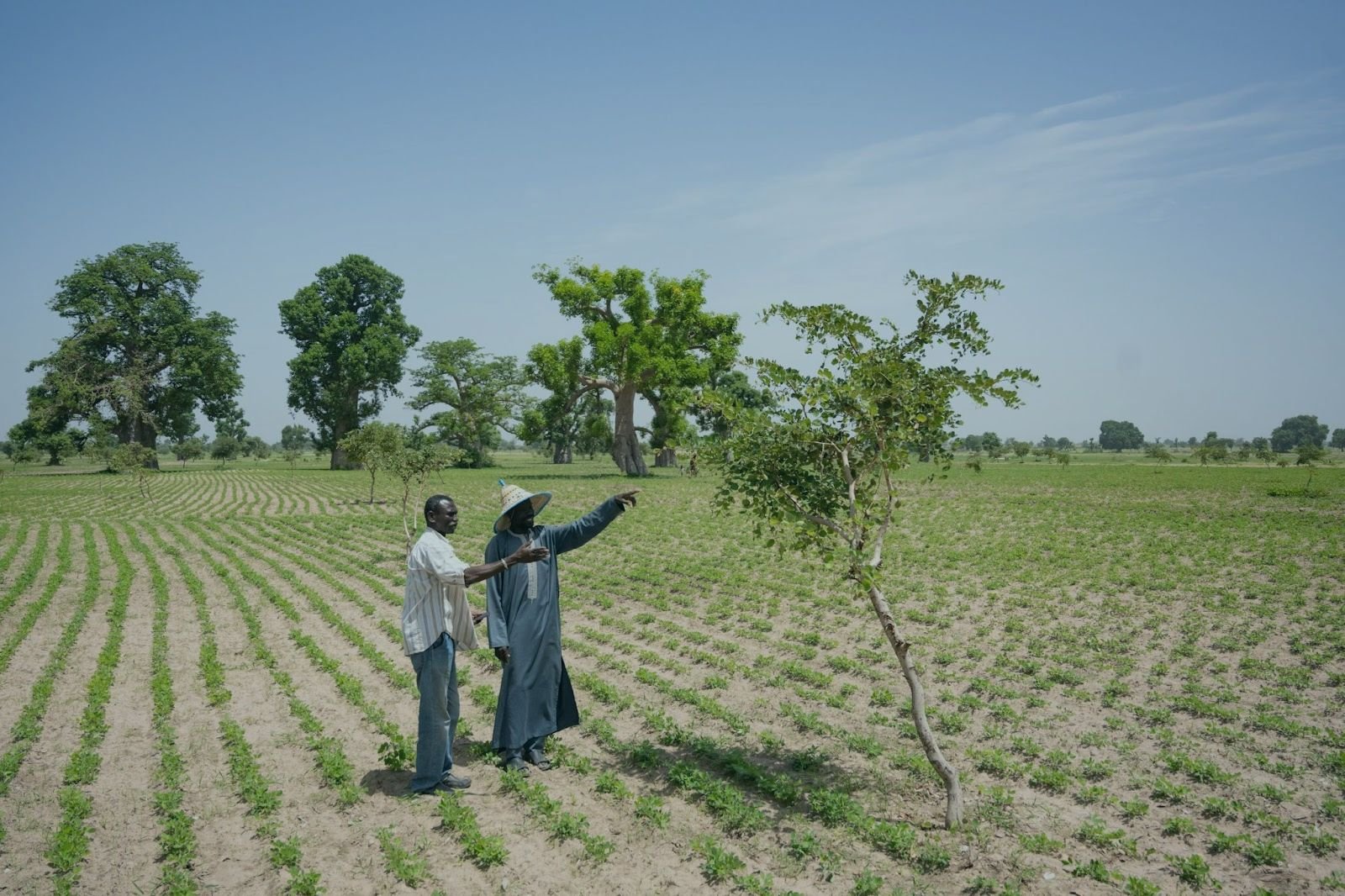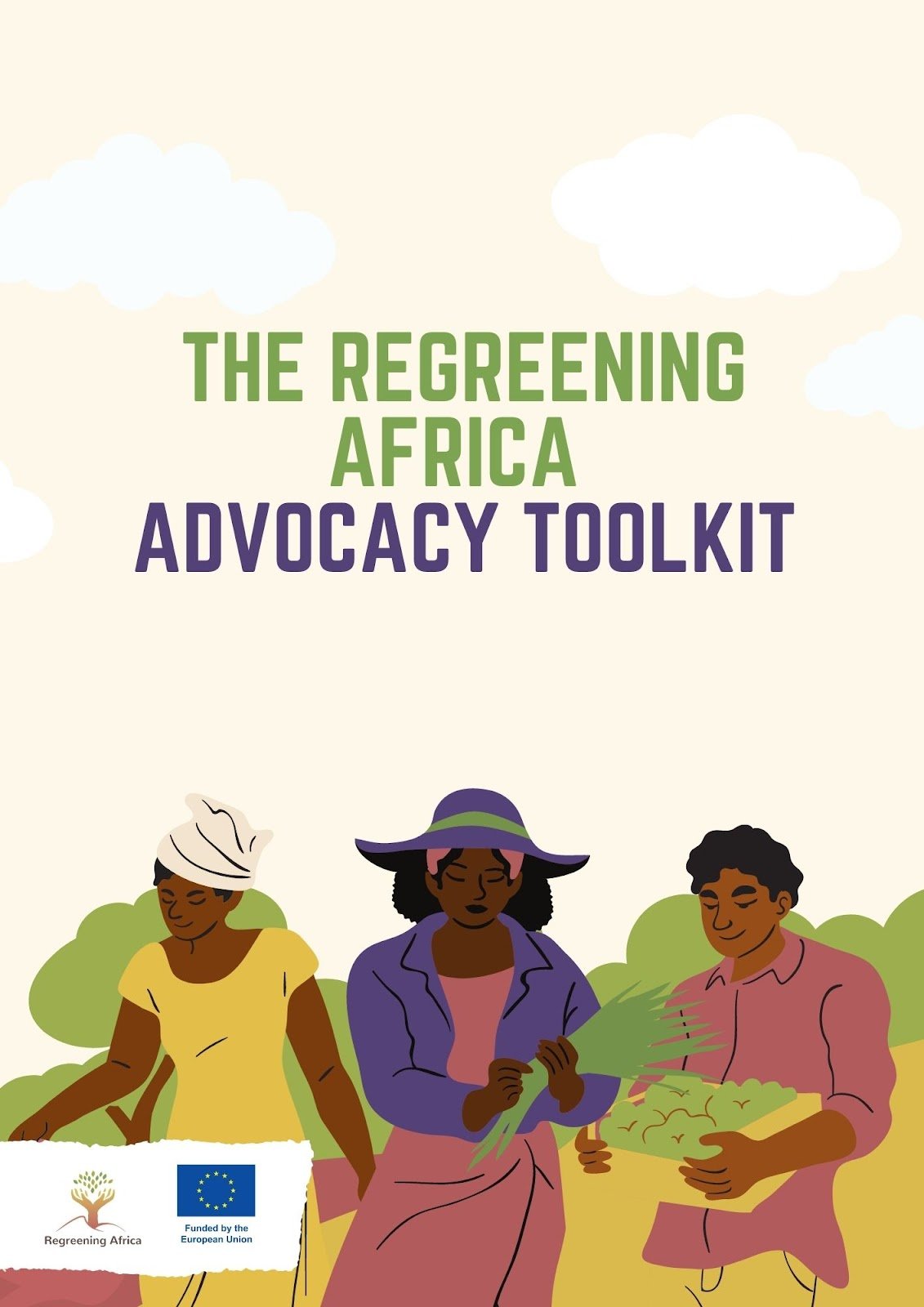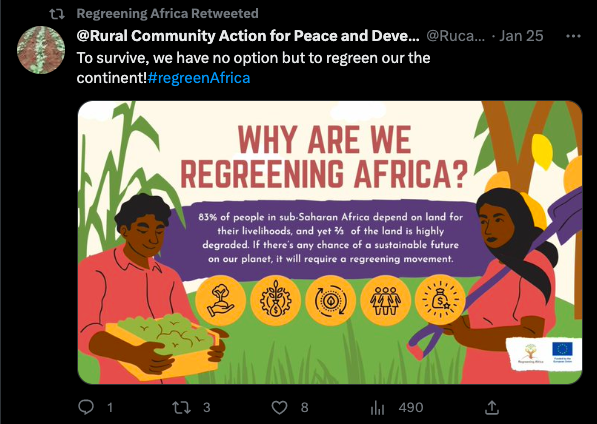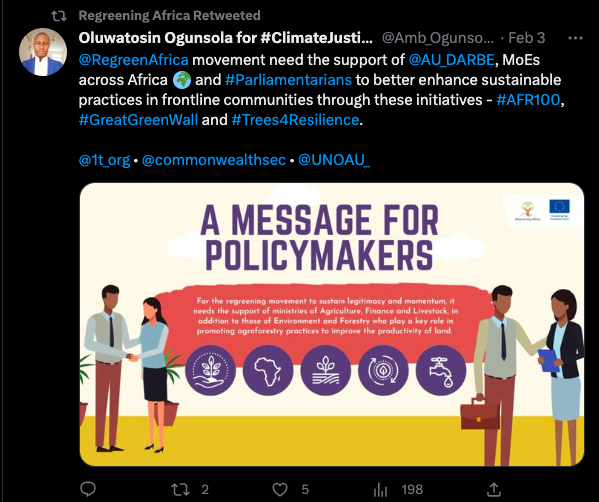Regreening Africa: Growing a Land Restoration Movement in Sub-Saharan Africa
Regreening Africa, backed by the EU, restores one million acres of degraded land in Sub-Saharan Africa, integrating trees to boost soil fertility and farmers' livelihoods.
Land is life. Fertile land and soil is the basis of healthy ecosystems, and productive farming and thriving local communities.
Regreening Africa, a large scale project backed by the European Union and implemented by the World Agroforestry Centre (ICRAF), aims to restore degraded land in Sub-Saharan Africa by integrating trees into land management across Kenya, Senegal, Rwanda, Ghana, Ethiopia, Mali, Niger, and Somalia.
The first phase of this epic project, which concluded in February 2023, aimed to restore 1 million acres of degraded land, while working with thousands of farmers to help them integrate trees that would enhance soil fertility, increase crop yields, and help sustain their livelihoods.
As the project concluded, Treeshake was tasked with telling their story, engaging their community of stakeholders, and helping lay the groundwork for continued application of the work through the local country partners.
Results
Contributing to the UN’s inspiring Great Green Wall initiative (https://www.unccd.int/our-work/ggwi) to restore 100 million hectares of currently degraded land; sequester 250 million tons of carbon and create 10 million green jobs by 2030.
What is Land Degradation
Degraded land refers to land that has lost its natural productivity due to human activities such as deforestation, overgrazing, intensive agriculture, and unsustainable land use practices. As a result, the land becomes less fertile, loses its ability to retain water, and is more susceptible to erosion, desertification, and other forms of land degradation. This can lead to reduced agricultural yields, food insecurity, and increased poverty for the people who rely on the land for their livelihoods.
Degraded land can also have negative environmental impacts, such as reduced biodiversity, increased greenhouse gas emissions, and decreased carbon sequestration. This can exacerbate the effects of climate change and further undermine the resilience of local communities and ecosystems.
Land Degradation in Southern Africa
Land degradation is a global issue affecting many regions, but sub-Saharan Africa is one of the most severely affected regions. The problem is particularly acute in this region due to a combination of factors, including high population growth rates, low agricultural productivity, limited access to modern technologies, and climate change impacts such as drought and desertification.
In addition, many countries in sub-Saharan Africa have experienced rapid deforestation, overgrazing, and other forms of unsustainable land use practices due to factors such as population pressure, poverty, and weak governance. This has exacerbated the problem of land degradation in the region.
While other regions of the world also face land degradation challenges, the severity and scale of the problem in sub-Saharan Africa make it one of the most affected regions. As such, efforts to address the issue in this region are critical to achieving global sustainable development goals.
Story
Excellent storytelling is imperative to an advocacy campaign’s success so the first step was setting the narrative. Science communication, however, is notoriously difficult and requires a high degree of accuracy. Additionally, Regreening Africa is a complex project, running in varying levels of specificity across 7 different countries using multiple languages. So, how did we distil these insights and turn them into a narrative that was compelling enough for people to talk and get excited about?
The Regreening Africa Journey, a social video showcasing the project’s objectives and targets, sets the project narrative by unpacking the 5ws and H of the project, and emphasising why land restoration is especially crucial. The video was produced using footage renowned photographer Kelvin Trautman had taken with the Regreening Africa communities in Rwanda, Senegal, Ghana and other participating countries. Commissioned by Treeshake to sharpen the quality of the project’s visual outputs, Kelvin shot beautiful imagery of the teams, farmers and community members at work, as well as the landscapes in various stages of restoration, which is now used across the project’s various platforms.
People
A second key component of advocacy is people. To turn Regreening Africa into a movement, we needed to increase the number of people speaking about the project. We needed to inspire and enable advocacy. We needed to broaden the take-up of the message and equip other organisations and stakeholders to speak about the wonderful work, the impact, and the lessons.
Relationships are a critical part of the landscape restoration process and the project owes much of its success to the involvement of local communities and partners in formulating restoration strategies and data collection and analysis. Knowing this, we kicked off our advocacy strategy by activating relationships with our stakeholders - strengthening those that already exist and being on the lookout for new alignments. We did this with stakeholder mapping exercises such as list-building, tagging our supporters and partners in our content and creating content around them —making them an even more active part of the regreening story and further creating a community around the project.
For example, Regreening Heroes is a showcase of 24 individuals and 8 organisations that Regreening Africa wanted to celebrate for their passionate contributions to restoring landscapes and improving the lives of communities across Sub-Saharan Africa. Compiled by Sandiso Matshikiza, the list highlights the women, farmers, youth, and partners who are instrumental to the effectiveness of regreening initiatives across the continent and deserve to be celebrated. #RegreeningHeroes has accrued over 73 000 impressions on Twitter to date, engaging the heroes featured and their networks, as well as our existing followers.
ACtion
At the heart of the advocacy strategy was the creation of an advocacy toolkit, a set of resources for people who want to help bring awareness to the issue of land degradation in sub-Saharan Africa. The toolkit highlights the role each of us can play in rehabilitating these landscapes and improving the quality of life for the communities that are dependent on them for their livelihoods. It is comprised of a collection of graphics and call-to-action messages about why we need a regreening movement, with messages directed at policymakers, development partners, faith communities, farmers, and other stakeholders. The toolkit is a ready-made social media campaign that users can just share on their profiles and other online platforms.
To activate the advocacy toolkit, we invited our partners and supporters to a series of Zoom meetings where we shared the toolkit with them and trained them on how to use it effectively. A specific timeframe for them to share the toolkit with their audiences was decided on, and follow ups made post the training, to ensure that everyone was clear on the plan and objective. On the day of activation, we reminded people to post from their platforms, as well as encouraging them to engage with other posts carrying the hashtag #RegreeningAfrica. Below are some examples of some of the posts shared by partners and community members.
The Regreening Africa Summit
To celebrate the culmination of five years of restoring landscapes and livelihoods and to share the impact achieved in those five years, Regreening Africa hosted the Regreening Africa Summit, a virtual event where Regreening Africa community members, farmers and project partners were joined by some notable names in the global impact space, like Acting Director of the European Commission Africa Hans Christian Stausboll, World Vision Australia’s Tony Rinaudo, Christophe Besacier from FAO and Susan Chomba from World Resources Institute.
The goal of the Summit was to unpack insights, lessons, and achievements from the programme, as well as the way forward for the project and landscape restoration on the continent in general. Through a social media and stakeholder outreach strategy, with beautiful graphics by Amy Staark, we managed to get over 1500 signups for the event, with just over 550 online attendees on the actual day of the Summit. Online, conversation around the Summit was buzzing too, with a Twitter reach of over 200 000 impressions and nearly 600 engagements in the two hours the event ran.
Regreening Africa is a model for other projects and initiatives that seek to promote sustainable development and improve people's lives, and an effective example of how, through agroecology and other relevant practices, scalable and replicable land restoration is possible. What an honour to work on this project!
Client:
Regreening Africa
In partnership with World Agroforestry and European Union
Treeshake Team
Strategy & Tech: Dave Duarte
Project Management: Sandiso Matshikiza
Content & Community: Mwabi Jere
PR: Aithne Molotsane
Resources:
Advocacy Toolkit: https://regreeningafrica.org/regreening-africa-advocacy-toolkit/
Regreening Africa video: https://youtu.be/1XUyv1PKibg
Regreening Heroes: https://regreeningafrica.org/regreening-heroes/
Recording of RA Summit: https://youtu.be/duMJ4SpaZ28
#BI4Gov: How a small, but deeply engaged community can have HUGE impact
How a new Twitter account with no followers and no paid media budget got a niche topic trending and reached over 2 million people in less than two weeks.
This case study is about how a new Twitter account with no followers and no paid media budget got a niche topic trending and reached over 2 million people in less than two weeks.
In late 2018, Treeshake helped launch #BI4Gov, a conference focused on how to use behavioural insights to successfully shape and implement policy, in a socially beneficial way. Through a partnership between the Western Cape Government (WCG) and the Organisation for Economic Co-operation and Development (OECD), experts from throughout the world came together to discuss the ins and outs of using BI in Government.
Starting with a brand new account with no followers on Twitter, and just two weeks to launch we knew that we’d be reliant on the voices of others with larger followings.
The first step was to set up the account to look as credible as it was - partner logos, clean design, and 3 high quality posts were set up. We then sent the page around to the team of collaborators and asked them to engage with the posts and follow so we’d have a bit of traction.
The next step was to tap into BI communities on Twitter, and identify thought leaders. We directly engaged around 60 followers ahead of the conference and directly asked them to follow us and help us get the #BI4Gov discussion going. We did this by email and direct message rather than publicly.
We found the BI enthusiasts supportive, warm, and welcoming to a new entrant to the space - this is partly thanks to declaring our agenda upfront, having the backing of the OECD, and introducing ourselves directly to the main thought leaders. This got the conversation rolling, and even with a relatively small following, everything we posted got a response.
The official Twitter account quickly gained around 150 followers. Without any paid advertising budget, we relied solely on consistent, authentic engagement with each member of the community. These followers were all highly skilled BI experts, each of whom had very strong links to the overall online BI community. This allowed for a higher degree of sophistication in the commentary and posts we put out, along with a much higher than average engagement rate.
On the day of the conference, the hashtag was visibly promoted at the conference, attended by around 300 people - many of whom had been contacted by the social media team ahead of time to let them know the importance of sharing their views. The result was that virtually everyone who attended participated in the online discussion, sharing substantive content that attracted public interest and media attention.
But it wasn’t all serious, either. As participants got to know each other, playful Twitter banter emerged in the form of ‘the sock saga’, with various speakers and organisers of the event comparing their funky sock choices. With the perfect mix of serious, insightful and fun, the #BI4Gov community blew us away with their deep engagement and commitment to the conversation.
Most importantly, the conference and public support for the issue has led to the establishment of South Africa’s first Behavioural Insights Unit in Government - #BI4Gov is here to stay.
The main take away from this? A small group of deeply engaged people can make a huge impact. Inspired by Cultural Anthropologist Margaret Mead, this is something we call The Mead Principle:
A tangible demonstration of the power of storytelling: The significant objects experiment
The Significant Objects experiment is a tangible demonstration of the power of storytelling in sales and marketing. Journalist Rob Walker purchased low value objects, for on average $1.25 and had great creative writers invent stories about them. He then posted the articles on e-Bay to see if the invented story enhanced the value of the object based on what price it achieves on auction.
It did.
The Significant Objects experiment is a tangible demonstration of the power of storytelling in sales and marketing.
Journalist Rob Walker purchased low value objects, for on average $1.25 and had great creative writers invent stories about them. He then posted the articles on e-Bay to see if the invented story enhanced the value of the object based on what price it achieves on auction.
It did.
An old pepper shaker was bought for 99 cents, and sold for $28.00. A butterfly embossed cigarette case was bought for 10 cents, and sold for $33.77. A horse bust was bought for 99c and sold for $62.95
All in all, 100 pieces were cost $128.74, and were sold for $3612.51 - a whopping 2780% increase in value.
That's story power.
This apple was bought for $1.00, and sold for $102.50 with a story.




















